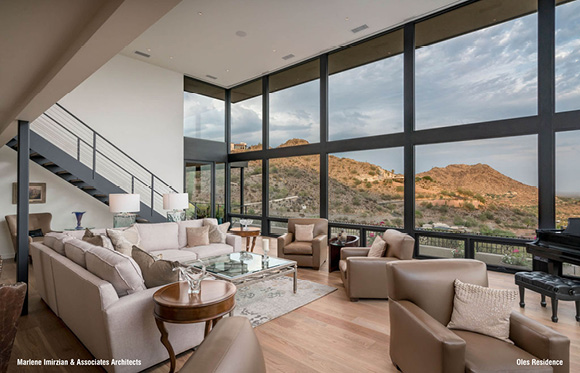These days, architect Marlene Imirzian, FAIA, has a lot of things on her mind. For one, she’s hoping to see her net-zero design, “Home NZ,” rise somewhere in Phoenix. She created the three-bedroom demonstration design as part of the City of Phoenix’ challenge to develop plans for an entry-level, budget-friendly, energy-efficient house. “The construction drawings are available at no cost,” says Imirzian, who is known for her sustainable approach to design. “You just have to find the lot and build it.”
She’s also devoting her energy to a residential renovation project in Paradise Valley, a cabin in Christopher Creek, a multi-family complex in Mesa and a public safety training center in San Diego, as well as recently finishing up an $85.6 million, 133,000-square-foot math and sciences building for Southwestern College in San Diego that’s on track for LEED Platinum certification. In between, she ponders how to get fresh air and natural ventilation into buildings, given the current pandemic situation and the focus on healthy design.
 Imirzian’s ability to hunker down with the details and keep an eye on the big picture goes back to her youth in Detroit, where she was raised in an Armenian family that supported education and achievement. “I do owe the start of my career to my high school government teacher,” she recalls. “I really didn’t even know what architecture was, but my teacher figured out that it was what I really wanted to do. He got on the phone and started dialing local architecture firms, asking if they would take me as an intern.”
Imirzian’s ability to hunker down with the details and keep an eye on the big picture goes back to her youth in Detroit, where she was raised in an Armenian family that supported education and achievement. “I do owe the start of my career to my high school government teacher,” she recalls. “I really didn’t even know what architecture was, but my teacher figured out that it was what I really wanted to do. He got on the phone and started dialing local architecture firms, asking if they would take me as an intern.”
The teacher—and Imirzian—lucked out. The firm that said yes was Gunnar Birkerts & Associates, internationally known for its soaring, elegant modernist work. “I wouldn’t even call that an ‘internship,’” Imirzian remembers with a laugh. “I was 17, and there weren’t a lot of women in the office at the time, but everyone there was so kind and supportive. They let me sit in on meetings. Gunnar became my mentor and let me see his sketches, his creative process. I was so lucky.”
She worked at the firm in between getting her bachelor’s and master’s degrees in architecture at the University of Michigan, then went to work for architect William Kessler, another notable Michigan modernist. “Working for Bill Kessler was another great gift,” Imirzian says. “He did big range of work, from historic restoration to contemporary work.”
The opportunity to work for a larger national firm brought her out to Phoenix in the 1990s and, by 1995, she decided to launch her own firm. “I worked out of a bedroom in my apartment,” Imirzian says. “I gave myself six months to make it.” Her first big-break projects were for Valley Lutheran Hospital in Mesa and Palomar College in San Diego. “I knew I had to get a real office and hire people for these jobs,” she says. “I also opened a second office in Escondido, California, about a year after Arizona.”
In Arizona, she landed in the Sunnyslope neighborhood of Phoenix, renovating a mid-century office building, where she now works with a team of ten. “I love Sunnyslope. It’s a historic, diverse community with great schools and transit—plus it’s right by the mountain preserve.”
Since opening her own practice, Imirzian has tackled everything from a restoration and adaptive reuse of the historic, 1925 Gold Spot market in Roosevelt Row to the sculptural and modern Bob and Renee Parsons Leadership Center for Girls and Women at Camp South Mountain. “It’s just as important to me to do a small project on a budget as a large-scale building. There’s potential in everything.”
do a small project on a budget as a large-scale building. There’s potential in everything.”
That approach has led to widespread recognition in the form of design awards (most recently a Crescordia from Arizona Forward and an AIA Arizona award for the South Mountain leadership center), as well as an Arizona AIA Firm of the Year award and an Architects Medal for Imirzian. Her work has also been widely published in magazines and included in design books.
“All of my projects are important to me. They are all compelling. That is the blessing of this career.”

